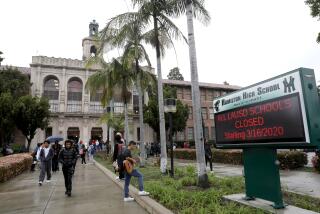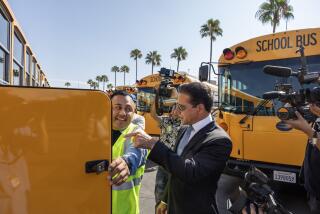Billions would be needed to repair L.A. schools, officials say
Maintaining Los Angeles Unified campuses will be difficult because of staffing and funding shortages combined with repair backlogs, aging buildings and more than 100 new schools, officials said Thursday.
During a meeting of a committee that oversees the spending of school construction bonds, the grim picture was illustrated by two contrasting photos.
The first showed the school district plumbing team from the 1990s. Squeezing into the frame are 23 people. That present-day team, photographed in January, numbered 10.
In the meantime, district property has increased substantially, from about 53 million square feet in 2001 to about 67 million square feet, according to the facilities division. Despite the new buildings, the average age of district structures is 52 years.
Attention has focused recently on the condition of schools because of district plans to devote more than $1 billion of bond funds to provide a computer to every student, teachers and campus administrator.
L.A. schools chief John Deasy said the effort is essential to keep learning methods and curriculum up to date and that no other funding source was available. The district has $7 billion from Measure Q, which was passed by voters in 2008. Of that, about $1 billion can be spent on technology, but the district also has identified about $40 billion in facility needs over the next few years.
Teachers and other critics recently contributed to a Facebook page called Repairs Not iPads, which called attention to problems such as broken water fountains and ceiling tiles, along with vermin infestations.
On Thursday, facilities chief Mark Hovatter said that problems identified on the Facebook page had been fixed. He also noted that such costs typically were absorbed by the general budget rather than from bond funds. In fact, many basic or emergency repairs must be paid for out of the general budget as part of ongoing maintenance and operations, he said.
The state recession led to deep budget cuts, which affected maintenance. For one thing, the state no longer required districts to set aside 3% of funding for maintenance. In 2007, that 3% came to more than $216 million. And even 3% annually is not enough to keep up, officials said. In 2012, the figure dropped to 1.3% or $88 million in a school system with about 13,500 buildings.
In addition, the state had been contributing $60 million annually to these costs. In 2008 the figure dropped to $30 million; in 2010, it plummeted to zero.
The effect has been predictable in a system that logs about 1,100 service calls daily. Unfinished calls at the end January 2012 numbered a little under 20,000. In September 2013, they peaked at close to 60,000. They have dipped to about 50,000 currently. Lack of regular maintenance also makes matters worse — and more expensive — over time.
“There is much to be done and there is not a lot of funding available,” Hovatter said.
Hovatter insisted, however, that the district has nonetheless improved its handling of maintenance, including such simple measures as making sure principals have his cellphone number. Recent improved funding also has allowed L.A. Unified to restore plant managers to every school. And analysts have been cataloguing in detail the condition of every school.
Still, the average response time for a service calls is about 60 days; not too long ago it was less than 20 days, said Roger Finstad, director of maintenance and operations.
“The M&O team is incredible,” but “severly underfunded,” Finstad said. “There is cause for concern.”
[For The Record, 11:30 a.m. PST Feb. 28: A previous version of this post listed incorrect figures for the number of service calls.]
howard.blume@latimes.com
Twitter: @howardblume |
More to Read
Sign up for Essential California
The most important California stories and recommendations in your inbox every morning.
You may occasionally receive promotional content from the Los Angeles Times.











